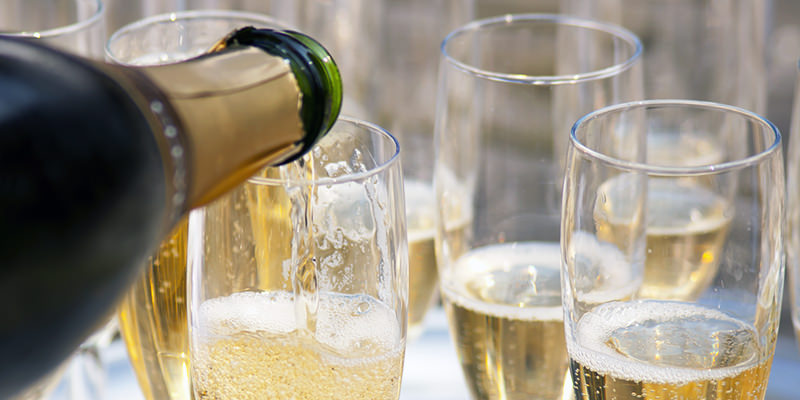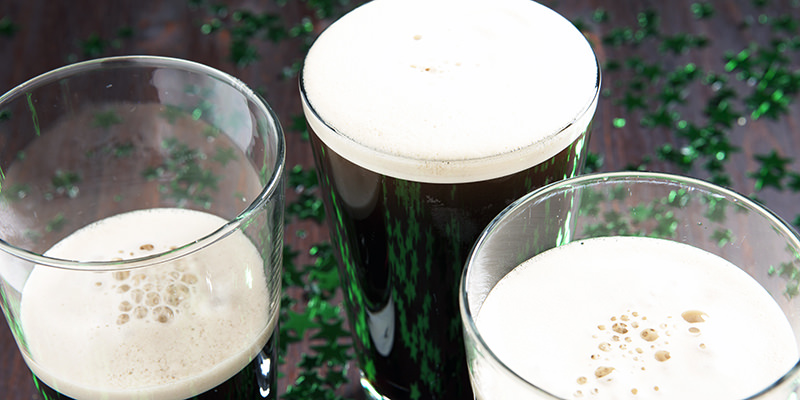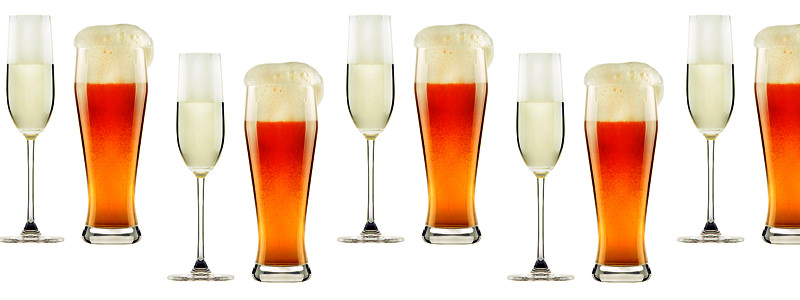What do a pint of ice-cold beer and a freshly popped bottle of Champagne have in common? Besides celebratory deliciousness, the answer is bubbles. However the nature of Champagne bubbles and beer foam (also known as the beer head), are a little different. Here’s why:
In order to make any sort of alcohol, fermentation has to occur. Fermentation is when yeast converts sugar into alcohol. One byproduct of fermentation is carbon dioxide, which causes the bubbles we love tasting in our beer and sparkling wine. When alcohol is bottled, this carbon dioxide is contained under pressure. In the bottle, where the pressure is high, the carbon dioxide disappears. However, when you open the bottle and lower the pressure, the carbon dioxide escapes in the form of bubbles. In Champagne and other sparkling wines, the bubbles pop, while in beer, the bubbles remain and form the beer’s head.

That’s because beer bubbles draw in molecules known as glycoproteins. Glycoproteins are surfactants, compounds that lower the surface tension between two liquids (or a liquid and a solid). You witness the miracle of surfactants every time you do your laundry, because detergents – a type of surfactant – lodge themselves between water and the gunk on your clothes, pulling those stains right off. When it comes to beer, surfactants create a membrane around the beer bubbles. This membrane prevents the bubbles from popping by allowing them to stick to nearby bubbles. So every time you savor a beer’s head, you’re enjoying the bubbles’ teamwork.
Lots of things can effect this bubble camaraderie, including temperature (the colder, the foamier), wearing chapstick (certain lip balms can destroy the foam), and, interestingly enough, if the glassware you drink your beer out of is etched. Nucleation – what makes bubbles occur – naturally takes place in certain cavities, so etched glassware will collect additional carbonation that builds until it’s bubbly enough to rise to the top of your beer. That’s also the reason behind why some glassmakers purposefully etch extremely small nucleation targets at the bottom of a wine bottle – to create those beautiful streams of bubbles. Beer makers also propose certain etched glasses to create just the right head.
If you’ve visited a quality Irish bar, you’ve probably witnessed another trick that preserves a beer’s head longer: the double pour. This technique is commonly used to build a Guinness, and it’s simple: fill a glass 2/3 of the way with beer, let it sit for a few minutes, then pour more beer into it. The second pour infiltrates the bubbles from the first ring of foam, bolstering the head to the top of the glass and protecting the fresh foam from the atmosphere.

The bubbles in sparkling wine may not form a creamy head, but they do yank good-smelling chemicals and fatty acids from within the wine to its surface. When each bubble pops, a hole opens at its top, growing rapidly and causing high pressure to hit the low-pressure area of the bubble’s bottom. This pressure crash sprays the aroma around the top of the wineglass, improving your wine’s perfume. So if you’re enjoying a particularly fragrant glass of Cava or Prosecco, thank those bubbles.
Both sparkling wine and a fizzy beer are delicious, but a beer with a super creamy head tends to pair better with more robust food (like a meat stew), whereas as a crisp sparkling wine accompanies lighter eats like cheese and crackers. In either case, you can thank science for the delicious bubbles behind your booze. Cheers!

